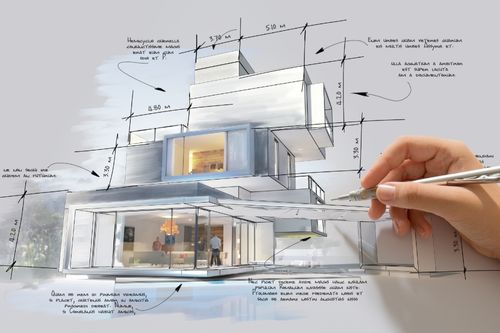Just How CDA Architects Combine Imagination and Performance in Modern Style
Wiki Article
Comprehending the Collaborative Refine Between Designers and Engineers in Modern Construction Projects
The joint procedure in between engineers and designers is essential in modern building and construction jobs, as it integrates style intent with design expediency. This partnership not just affects the visual and functional elements of a task yet likewise plays an essential duty in attending to sustainability obstacles. By using effective communication methods and leveraging innovative technologies, such as Building Information Modeling (BIM), teams can work much more cohesively. The intricacies of this collaboration frequently present unique challenges that can hinder progress. Discovering these dynamics reveals understandings that can dramatically influence task results and overall market requirements. cda architects.The Relevance of Partnership
The collaborative harmony between architects and designers is vital for the successful understanding of any type of construction task. This partnership unites unique competence and perspectives, making it possible for the combination of innovative style with practical design services. By functioning together, engineers and engineers can make sure that a project not just meets aesthetic and useful demands yet also sticks to safety, sustainability, and financial constraints.Partnership cultivates a shared vision, assisting in the placement of objectives and assumptions from the outset. This placement is essential in resolving potential challenges and mitigating risks that might occur throughout the job lifecycle. A collaborative approach allows for the efficient allocation of sources, maximizing both time and price.
The relevance of cooperation includes the repetitive process of style and construction, where feedback from engineers can educate building decisions, causing even more viable and lasting layouts. Conversely, architects can inspire engineers to think creatively about how to achieve structural integrity without compromising artistic intent. Ultimately, the collaborative relationship in between engineers and designers is not just valuable; it is basic to the production of top quality, functional, and ingenious built atmospheres that meet the requirements of society.
Communication Strategies and Tools
Efficient interaction strategies and tools are essential for promoting partnership between designers and engineers throughout the project lifecycle. Developing clear networks of communication is important to guarantee that all staff member are straightened with job objectives, timelines, and responsibilities. Normal meetings, both in-person and virtual, give possibilities for stakeholders to go over development, address concerns, and make educated decisions.
In addition, adopting collective interaction devices, such as Slack or Microsoft Teams, enables immediate messaging, documents sharing, and ongoing conversations, advertising a more nimble action to arising issues. File administration systems additionally play an essential function in arranging task documentation, guaranteeing that all employee have access to the current details.
a knockout post
Shared Goals and Task Vision
A merged job vision works as the foundation for effective cooperation between architects and engineers (cda architects). This shared vision not only straightens the efforts of both celebrations however likewise develops a common framework for additional hints decision-making throughout the job's lifecycle. By expressing clear objectives, stakeholders can properly navigate the intricacies of modern-day building tasks, making sure that both aesthetic and useful needs are fulfilledEstablishing common goals entails open dialogue and a detailed understanding of each technique's payments. Engineers commonly concentrate on design intent, spatial relationships, and user experience, while designers stress architectural stability, systems functionality, and conformity with laws. When these viewpoints are aligned, the result is a natural project that sticks to both innovative aspirations and technical feasibility.
Additionally, a distinct job vision cultivates responsibility among employee, motivating each individual to take ownership of their role in attaining the desired outcome. Routine check-ins and joint workshops can better enhance this commitment, permitting changes to be made as the project advances. Eventually, a common vision not just improves synergy yet additionally boosts the quality of the last deliverable, leading to effective job completion.
The Duty of Innovation
Leveraging technology has ended up being necessary in improving cooperation in between engineers and engineers. Building Info Modeling (BIM) stands out as a critical modern technology, allowing both designers and engineers to create detailed 3D models that encapsulate design intent and structural stability.Furthermore, cloud-based platforms enable smooth collaboration, allowing job stakeholders to accessibility and update project data from anywhere. This fosters a culture of openness and liability, as modifications can be tracked and evaluated in real-time. In addition, mobile applications additional enhance communication, supplying on-site groups with prompt accessibility to job specifications and updates.
Arising innovations such as fabricated intelligence and artificial intelligence are likewise starting to contribute in predictive evaluation, helping teams recognize potential concerns prior to they emerge. Inevitably, the duty of modern technology in architecture-engineering collaboration not only enhances workflow efficiencies but likewise boosts advancement, resulting in more effective task results. By accepting these technical developments, architects and designers can guarantee an extra cohesive and effective joint procedure throughout the building lifecycle.
Case Research Studies in Successful Partnerships
Many study illustrate the profound effect of reliable collaborations between designers and engineers on job end results. One notable example is the collaboration on the High Line in New York City, where landscape designers, engineers, and city coordinators functioned together to change an abandoned railway right into a dynamic public park. This multidisciplinary technique not only boosted the visual quality yet also ensured structural security and environmental sustainability.
The Burj Khalifa in Dubai even more demonstrates the value of joint initiatives - her response cda architects. The integration of style and engineering competence allowed the job team to accomplish extraordinary elevations while sticking to safety and security guidelines and aesthetic vision
These examples highlight the significance of communication, trust, and shared goals. In today's complex construction atmosphere, such collaborations are necessary to navigating obstacles and delivering projects that satisfy both practical and visionary objectives.
Conclusion
In final thought, the partnership between architects and engineers is essential for the success of modern-day building tasks. Efficient communication techniques, a common job vision, and the assimilation of sophisticated innovations are important components that promote this partnership.Report this wiki page